
Bandwings, or band-winged grasshoppers, are the subfamily Oedipodinae of grasshoppers classified under the family Acrididae. They have a worldwide distribution and were originally elevated to full family status as the Oedipodidae. Many species primarily inhabit xeric weedy fields, and some are considered to be important locusts:
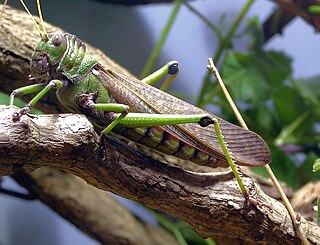
The Romaleidae or lubber grasshoppers are a family of grasshoppers, based on the type genus Romalea. The species in this family can be found in the Americas. It is known to be polyphagous, but there is not much else known regarding its diet.

Trigonidiinae is a subfamily of insects in the order Orthoptera, suborder Ensifera, based on the type genus Trigonidium. They are often referred to as sword-tail crickets, winged bush crickets or trigs.

The Phaneropterinae, the sickle-bearing bush crickets or leaf katydids, are a subfamily of insects within the family Tettigoniidae. Nearly 2,060 species in 85 genera throughout the world are known. They are also known as false katydids or round-headed katydids.
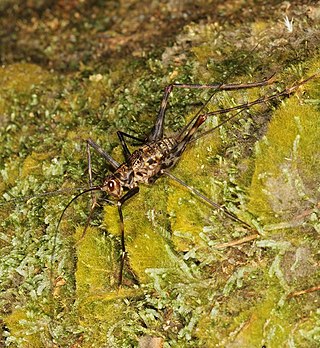
Phalangopsinae, occasionally known as spider crickets, are a subfamily of crickets in the family Phalangopsidae. Members of Phalangopsinae are found worldwide in tropical and subtropical regions. Most species in the subfamily are nocturnal and can be found in rocky areas, near fallen wood, and the understory of forests. Some species are gregarious, gathering in large numbers.

The Eneopterinae are a subfamily of crickets, in the family Gryllidae, based on the type genus Eneoptera. It is one of several groups widely described as "true crickets", but this subfamily may also referred to in American English as "bush crickets". Of the more than 500 species that make up this subfamily, most occur in moist, tropical habitats. These insects are medium to large and brown or gray in color. They eat plant leaves, flowers, and fruits and can occasionally cause economic damage. Their eggs are deposited in pith, bark, or wood. Eneopterinae show a great diversity in stridulatory apparatus, signals emitted, and associated behaviour.
Gavialidium is a genus of insects found in India and Sri Lanka, belonging to the Tetrigidae family of Orthopterans in the tribe Discotettigini.
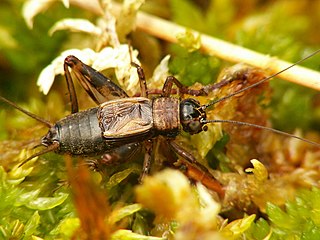
Nemobiinae is a subfamily of the newly constituted Trigonidiidae, one of the cricket families. The type genus is Nemobius, which includes the wood cricket, but members of this subfamily may also be known as ground crickets or "pygmy field crickets".
Hygronemobius is a genus of insects in the family Trigonidiidae.

The Pseudophyllodromiinae are a subfamily of cockroaches, in the family Ectobiidae, with a world-wide distribution.
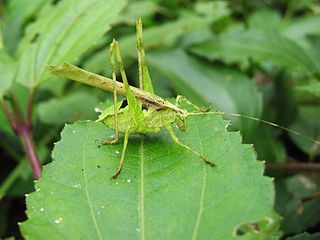
Insara, commonly known as western bush katydids, is a genus of katydids in the family Tettigoniidae.

Rhammatocerus is a genus of grasshoppers in the subfamily Gomphocerinae and the tribe Scyllinini. There are about 16 described species in Rhammatocerus, including R. schistocercoides, the "Mato Grosso locust".

Lactista is a genus of band-winged grasshoppers in the family Acrididae. There are about 10 described species in Lactista.
Montezumina is a genus of North, Central, and South American phaneropterine katydids in the family Tettigoniidae. There are at least 30 described species in Montezumina.

Ripipterygidae is a family of insects in the order Orthoptera. Members of the family are commonly known as mud crickets.

Leptomantella is a genus of praying mantids and typical of the new (2019) family Leptomantellidae. Species have been recorded from Asia.

The Phalangopsidae are a recently reconstituted family of crickets, based on the type genus PhalangopsisServille, 1831 from South America. Priority for family-group names based on this genus dates from Blanchard's "Phalangopsites".

Gryllini is a tribe of crickets and typical of the family Gryllidae. Species are terrestrial, carnivorous or omnivorous and can be found in all continenents except Antarctica.
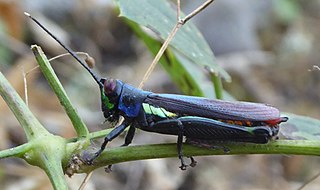
Proctolabus is a genus of short-horned grasshoppers in the family Acrididae. There are about eight described species in Proctolabus, found in Mexico and the southwestern United States.
Luzarinaeis a subfamily of crickets in the family Phalangopsidae.















